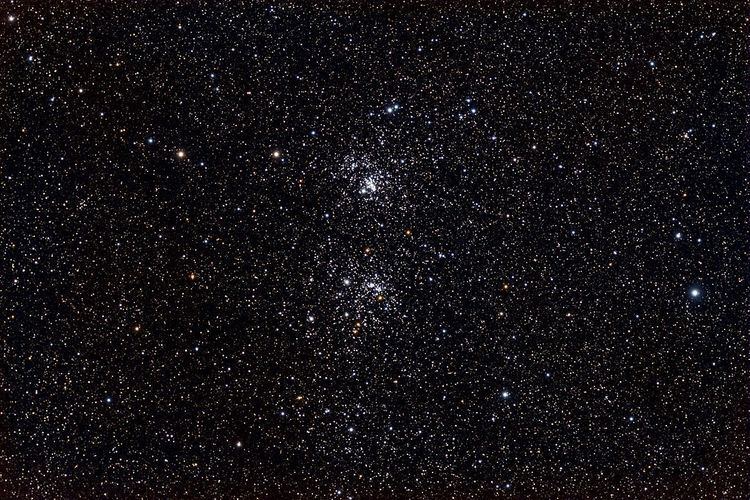Declination 57° 08′ Apparent magnitude (V) 3.7 and 3.8 | Right ascension 2 20 Distance 7.5 kly (2300 Pc) Apparent dimensions (V) 60′ | |
 | ||
The Double Cluster (also known as Caldwell 14) is the common name for the open clusters NGC 869 and NGC 884 (often designated h Persei and χ Persei, respectively), which are close together in the constellation Perseus. Both visible with the naked eye, NGC 869 and NGC 884 lie at a distance of 7500 light years. NGC 869 has a mass of 3700 solar masses and NGC 884 weighs in at 2800 solar masses; however, later research has shown both clusters are surrounded with a very extensive halo of stars, with a total mass for the complex of at least 20,000 solar masses. Based on their individual stars, the clusters are relatively young, both 12.8 million years old. In comparison, the Pleiades have an estimated age ranging from 75 million years to 150 million years. There are more than 300 blue-white super-giant stars in each of the clusters. The clusters are also blueshifted, with NGC 869 approaching Earth at a speed of 39 km/s (24 mi/s) and NGC 884 approaching at a similar speed of 38 km/s (24 mi/s). Their hottest main sequence stars are of spectral type B0.
Contents
Mythology
Perseus is the mythological symbol of adventure. Perseus was born the son of the Greek god Zeus. Along with beheading Medusa, Perseus performed other heroic deeds as well, such as saving Andromeda who was a princess chained to a rock as a sacrifice to a sea monster. Due to his great accomplishments, the gods placed Perseus among the stars, with the head of Medusa in one hand and the jeweled sword in the other. The Double Cluster represents the jeweled handle of Perseus’s sword.
History
Hipparchus, a Greek astronomer, cataloged the object (a patch of light in Perseus) as early as 130 B.C. However, the true nature of the Double Cluster wasn’t discovered until the invention of the telescope many centuries later. In the early 19th century William Herschel was the first to recognize the object as two separate clusters. The Double Cluster is not included in Messier's catalog, but is included in the Caldwell catalogue of popular deep-sky objects not in Messier.
Location
The Double Cluster is circumpolar (continuously above the horizon) from most northern temperate latitudes. It is in close proximity to the constellation Cassiopeia. The Double Cluster is approximately the radiant of the Perseid meteor shower, which peaks annually around August 12 or 13. Although easy to locate in the northern sky, observing the Double Cluster in its two parts requires optical aid. They are described as being an "awe-inspiring" and "breathtaking" sight, and are often cited as a target in astronomy observer's guides.
